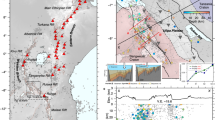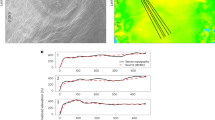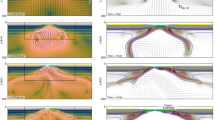Abstract
Continental rifting requires weak zones to exist within the strong continental plates. This weakening is thought to be induced primarily by high hydrogen contents and temperatures, as well as small grain size1,2,3. An ideal location to test models of plate strength in situ is the East African Rift4—the best exposed continental rift on Earth—which is forming adjacent to the unrifted Tanzanian Craton. Here I use magnetotelluric data to investigate electrical conductivity, and hence hydrogen content5,6, across the East African Rift and Tanzanian Craton. The images show that the Tanzanian Craton is extremely rich in hydrogen, whereas the parts of the continent that are being rifted are anhydrous, suggesting that high hydrogen content does not systematically reduce plate strength. Earlier deformation events7 may have reduced the grain size of the continental lithosphere in the East African Rift8,9 compared to the Tanzanian Craton10,11. I therefore suggest that the localization of rifting and repeated reactivation of deformed regions may not be due to hydrogen content and is instead controlled by small grain size.
This is a preview of subscription content, access via your institution
Access options
Subscribe to this journal
Receive 12 print issues and online access
$259.00 per year
only $21.58 per issue
Buy this article
- Purchase on Springer Link
- Instant access to full article PDF
Prices may be subject to local taxes which are calculated during checkout




Similar content being viewed by others
References
Bercovici, D. & Ricard, Y. Mechanisms for the generation of plate tectonics by two-phase grain-damage and pinning. Phys. Earth Planet. Inter. 202, 27–55 (2012).
Hirth, G. & Kohlstedt, D. L. Water in the oceanic upper mantle: Implications for rheology, melt extraction and the evolution of the lithosphere. Earth Planet. Sci. Lett. 144, 93–108 (1996).
Karato, S-I. & Jung, H. Effects of pressure on high-temperature dislocation creep in olivine. Phil. Mag. 83, 401–414 (2003).
Chorowicz, J. The East African rift system. J. Afr. Earth Sci. 43, 379–410 (2005).
Wang, D., Mookherjee, M., Xu, Y. & Karato, S-i. The effect of water on the electrical conductivity of olivine. Nature 443, 977–980 (2006).
Yoshino, T., Matsuzaki, T., Shatskiy, A. & Katsura, T. The effect of water on the electrical conductivity of olivine aggregates and its implications for the electrical structure of the upper mantle. Earth Planet. Sci. Lett. 288, 291–300 (2009).
Tommasi, A. & Vauchez, A. Continental rifting parallel to ancient collisional belts: An effect of the mechanical anisotropy of the lithospheric mantle. Earth Planet. Sci. Lett. 185, 199–210 (2001).
Möller, A., Mezger, K. & Schenk, V. U–Pb dating of metamorphic minerals: Pan-African metamorphism and prolonged slow cooling of high pressure granulites in Tanzania, East Africa. Precambr. Res. 104, 123–146 (2000).
Fritz, H. et al. Central Tanzanian tectonic map: A step forward to decipher Proterozoic structural events in the East African Orogen. Tectonics 24, TC6013 (2005)
Vauchez, A., Dineur, F. & Rudnick, R. Microstructure, texture and seismic anisotropy of the lithospheric mantle above a mantle plume: Insights from the Labait volcano xenoliths (Tanzania). Earth Planet. Sci. Lett. 232, 295–314 (2005)
Jones, T., Russell, J., Porritt, L. & Brown, R. Morphology and surface features of olivine in kimberlite: Implications for ascent processes. Solid Earth 5, 313–326 (2014).
Fei, H., Wiedenbeck, M., Yamazaki, D. & Katsura, T. Small effect of water on upper-mantle rheology based on silicon self-diffusion coefficients. Nature 498, 213–215 (2013).
Ebinger, C. J. & Sleep, N. Cenozoic magmatism throughout east Africa resulting from impact of a single plume. Nature 395, 788–791 (1998).
O’Donnell, J., Adams, A., Nyblade, A., Mulibo, G. & Tugume, F. The uppermost mantle shear wave velocity structure of eastern Africa from Rayleigh wave tomography: Constraints on rift evolution. Geophys. J. Int. 194, 961–978 (2013).
Selway, K., Yi, J. & Karato, S-I. Water content of the Tanzanian lithosphere from magnetotelluric data: Implications for cratonic growth and stability. Earth Planet. Sci. Lett. 388, 175–186 (2014).
Selway, K. On the causes of electrical conductivity anomalies in tectonically stable lithosphere. Surv. Geophys. 35, 219–257 (2014).
Desissa, M. et al. A mantle magma reservoir beneath an incipient mid-ocean ridge in Afar, Ethiopia. Nature Geosci. 6, 861–865 (2013).
Li, S. et al. Partial melt or aqueous fluid in the mid-crust of Southern Tibet? Constraints from INDEPTH magnetotelluric data. Geophys. J. Int. 153, 289–304 (2003).
Sifré, D. et al. Electrical conductivity during incipient melting in the oceanic low-velocity zone. Nature 509, 81–85 (2014).
Ni, H., Keppler, H. & Behrens, H. Electrical conductivity of hydrous basaltic melts: Implications for partial melting in the upper mantle. Contrib. Mineral. Petrol. 162, 637–650 (2011).
Nonnotte, P. et al. Petrology and geochemistry of alkaline lava series, Kilimanjaro, Tanzania: New constraints on petrogenetic processes. Geol. Soc. Am. Spec. Pap. 478, 127–158 (2011).
Dai, L. & Karato, S-i. The effect of pressure on the electrical conductivity of olivine under the hydrogen-rich conditions. Phys. Earth Planet. Inter. 232, 51–56 (2014).
Green, D. H., Hibberson, W. O., Kovács, I. & Rosenthal, A. Water and its influence on the lithosphere-asthenosphere boundary. Nature 467, 448–451 (2010).
Hirth, G. & Kohlstedt, D. in Inside the Subduction Factory (ed. Eiler, J.) 83–105 (American Geophysical Union, 2004).
Peslier, A. H., Woodland, A. B., Bell, D. R. & Lazarov, M. Olivine water contents in the continental lithosphere and the longevity of cratons. Nature 467, 78–81 (2010).
Doucet, L. S. et al. High water contents in the Siberian cratonic mantle linked to metasomatism: An FTIR study of Udachnaya peridotite xenoliths. Geochim. Cosmochim. Acta 137, 159–187 (2014).
Girard, J., Chen, J., Raterron, P. & Holyoke, C. W. Hydrolytic weakening of olivine at mantle pressure: Evidence of [100](010) slip system softening from single-crystal deformation experiments. Phys. Earth Planet. Inter. 216, 12–20 (2013).
Julià, J., Ammon, C. J. & Nyblade, A. A. Evidence for mafic lower crust in Tanzania, East Africa, from joint inversion of receiver functions and Rayleigh wave dispersion velocities. Geophys. J. Int. 162, 555–569 (2005).
Nyblade, A. A., Pollack, H. N., Jones, D., Podmore, F. & Mushayandebvu, M. Terrestrial heat flow in east and southern Africa. J. Geophys. Res. 95, 17371–17384 (1990).
Wark, D. A. & Watson, E. B. Effect of grain size on the distribution and transport of deep-seated fluids and melts. Geophys. Res. Lett. 27, 2029–2032 (2000).
Buck, W. The role of magma in the development of the Afro-Arabian Rift System. Geol. Soc. Lond. Spec. Publ. 259, 43–54 (2006).
Acknowledgements
This work was funded by Australian Research Council grant DP0988263 and also supported by National Science Foundation grant EAR1110921. I am grateful to COSTECH, regional and district governments and locals in Tanzania for permission to carry out field work, as well as the University of Dar es Salaam, M. Khalfan and G. Boren for assistance in field work.
Author information
Authors and Affiliations
Contributions
K.S. designed the experiment, led the field work, conducted the analysis and wrote the manuscript.
Corresponding author
Ethics declarations
Competing interests
The author declares no competing financial interests.
Supplementary information
Supplementary Information
Supplementary Information (PDF 3467 kb)
Rights and permissions
About this article
Cite this article
Selway, K. Negligible effect of hydrogen content on plate strength in East Africa. Nature Geosci 8, 543–546 (2015). https://doi.org/10.1038/ngeo2453
Received:
Accepted:
Published:
Issue Date:
DOI: https://doi.org/10.1038/ngeo2453
This article is cited by
-
Displaced cratonic mantle concentrates deep carbon during continental rifting
Nature (2020)
-
Uplift of the central transantarctic mountains
Nature Communications (2017)



